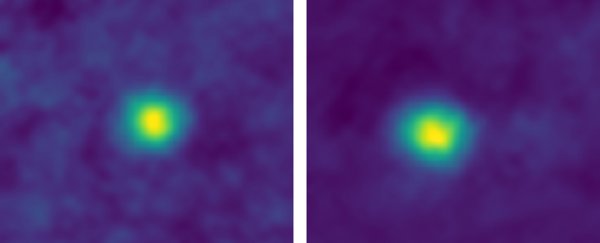The NASA New Horizons probe just set a new interstellar exploration record, taking pictures from further out in space than ever before – it snapped the shots you see above some 6.12 billion kilometres (3.79 billion miles) away from Earth.
That's about 6 million kilometres (3.7 million miles) further out than the Voyager 1 spacecraft was when it captured the famous Pale Blue Dot image of Earth back in 1990. Since Voyager 1's cameras were turned off shortly after that shot was taken, the record has stood for the past 27 years.
The new record-breaking photos show two Kuiper Belt objects, 2012 HZ84 and 2012 HE85. As fuzzy as they are, they're the closest look we've ever got at any objects inside this vast icy ring, which circles the Sun about 30 to 55 times further out than Earth.
"New Horizons has long been a mission of firsts – first to explore Pluto, first to explore the Kuiper Belt, fastest spacecraft ever launched," says New Horizons Principal Investigator Alan Stern, from the Southwest Research Institute in Boulder, Colorado.
"And now, we've been able to make images farther from Earth than any spacecraft in history."
In fact, New Horizons broke the record twice in quick succession, first snapping a shot of a group of distant stars called the Wishing Well, around 1,300 light-years away from our planet. That was followed up with the shots of the Kuiper Belt two hours later.
These photos were captured in December by the Long Range Reconnaissance Imager (LORRI) on board New Horizons, and were shot just before it went back into hibernation.
New Horizons first left Earth in 2006 with the aim of flying by Pluto, which it did in 2015, taking some dramatic photos along the way. Since then it's been heading into the Kuiper Belt, and will carry out a flyby of Kuiper Belt object (KBO) 2014 MU69 in January 2019.
 The Wishing Well star cluster. (NASA/JHUAPL/SwRI)
The Wishing Well star cluster. (NASA/JHUAPL/SwRI)
By that time 2014 MU69 should have a catchier name attached to it – NASA is asking for suggestions.
The probe continues to cover around 1.1 million kilometres or 700,000 miles of deep space every day, and is only the fifth man-made object in history – after Pioneer 10, Pioneer 11, Voyager 2, and Voyager 1 – to be on course to fly beyond the reaches of our Solar System.
As anyone who's ever tried to keep a camera steady will know, taking pictures at that speed is an impressive feat.
Before we eventually lose touch with New Horizons, it's hoped that it will tell us plenty more about the Kuiper Belt. The probe is measuring levels of plasma, dust, and gases as it travels, and will eventually take a look at more than 20 other KBOs.
New Horizons is going to get nudged out of hibernation again on the 4th of June. In the meantime, we can marvel at these record-breaking deep space photographs.
